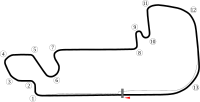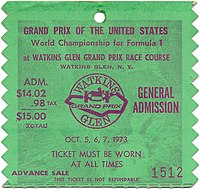United States Grand Prix: Difference between revisions
Undid revision 231238571 by 209.2.60.98 (talk) |
Undid revision 231238708 by 209.2.60.98 (talk) |
||
| Line 3: | Line 3: | ||
Name = [[United States]] Grand Prix | |
Name = [[United States]] Grand Prix | |
||
Circuit = [[Indianapolis Motor Speedway]] | |
Circuit = [[Indianapolis Motor Speedway]] | |
||
Circuit_image = [[Image:Indianapolis Motor Speedway - road course.svg]] | |
Circuit_image = [[Image:Indianapolis Motor Speedway - road course.svg|200px]] | |
||
Laps = 73 | |
Laps = 73 | |
||
Circuit_length_km = 4.19 | |
Circuit_length_km = 4.19 | |
||
Revision as of 14:49, 11 August 2008
| Indianapolis Motor Speedway | |
 | |
| Race information | |
|---|---|
| Most wins (drivers) | |
| Most wins (constructors) | |
| Circuit length | 4.19 km (2.60 miles) |
| Race length | 306.02 km (190.15 miles) |
| Laps | 73 |
| Last race (2007) | |
| Pole position | |
| |
| Podium | |
| |
| Fastest lap | |
| |
The United States Grand Prix is a motor race which has been run on and off since 1908, when it was known as the American Grand Prize. The race later became part of the Formula One World Championship.
History

American Grand Prize
The race was known as the American Grand Prize from its start in 1908 to 1916.
Revival
The United States Grand Prix was revived on October 12, 1958 as a sports car race at Riverside International Raceway. The race formed part of the USAC Road Racing Championship and the American Chuck Daigh won in a Scarab, beating Dan Gurney's Ferrari into second place.[1]
Sebring
Russian-born Alec Ulmann organized the first Formula One American Grand Prix on the road course at Sebring, Florida in December, 1959 as the last race of the season.
The starting grid included seven American drivers, but New Zealand's Bruce McLaren, in a Cooper, took his first win in F1 and was, at the time, the youngest driver ever to win a Grand Prix. McLaren took the lead on the last lap of the race when his team-mate, Jack Brabham, ran out of fuel. Brabham had to push his car over the line to finish fourth and clinch his and the team's first World Championships.
Despite providing an exciting climax to the season, the race wasn't successful from the hosts' standpoint, as the promoters barely broke even.
Return to Riverside
Ulmann moved the race to the Riverside International Raceway in Riverside, California in 1960. Stirling Moss put on quite a show in his privately-entered Lotus by winning from the pole. However, while the driver's purse was enormous (as at Sebring), the event was received no better than the previous year's and became another one-off.

Watkins Glen
In 1961, however, when Cameron Argetsinger was asked to host the race in Watkins Glen, New York, where international road racing was well established, the third time was indeed the charm, as F1 found the United States Grand Prix's home at The Glen. Over the next twenty years, the event became a cherished tradition among the fans as loyal crowds gathered each year on the wooded hills of up state New York. It was one of the season's most popular events with the teams and drivers as well, receiving the Grand Prix Drivers' Association award for the best organized and best staged GP of the season in 1965, 1970, and 1972. From 1976 to 1980 the race was called the United States Grand Prix East to differentiate from the United States Grand Prix West held in Long Beach the same years. In 1980, financial difficulties and the inability of the circuit to safely handle the increasingly faster and stiffer ground effect cars of the era led to the Glen's exit from the Formula One calendar after Alan Jones won the 1980 race for Williams. Since then, no United States Grand Prix has been held on a natural road course.
Long Beach
See United States Grand Prix West.
Las Vegas
See Las Vegas Grand Prix.
Detroit
See United States Grand Prix East.
Dallas
The Vegas course left the schedule after just two seasons, and there were plans for a New York Grand Prix in 1983 to replace it, but this was cancelled unexpectedly in mid-year.
In 1984, the United States Grand Prix moved to Dallas, Texas, joining the United States Grand Prix East in Detroit, Michigan.
The race track was laid out on surface streets surrounding Texas State Fair Park. However the Fair Park circuit sustained damage during a support race and required repairs to be made to it the morning of the Formula One race. The F1 race, combined with the oppressive heat caused the track further damage.
The race was largely considered a disaster and Formula One did not return, leaving the United States Grand Prix East as the only F1 race in the United States.
Phoenix
Plans to continue Formula One races in the Detroit area at the nearby Belle Isle did not materialize, and in 1989, Formula One moved to Phoenix, Arizona. The Phoenix street circuit was laid out in down town Phoenix and was unpopular with drivers and the local crowd. After the race in 1991 was attended by little more than 18,000 spectators, Formula One left and did not return to the United States until 2000.
Indianapolis

It was not until 2000 that another United States Grand Prix took place, this time at legendary Indianapolis Motor Speedway. The 2.606-mile (4.194 km) infield road course uses approximately one mile of the storied oval, but in a clockwise direction. This is distinctly different from most United States motor racing, which is run counter-clockwise. However, it follows the general procedure of F1, in which the vast majority of races are run clockwise. The crowd at the 2000 race was estimated at over 225,000, perhaps the largest ever in F1. Michael Schumacher's win was his second of four straight to end the season as he overtook Mika Häkkinen for his third Championship. In 2001, the race went off less than three weeks after the events on September 11, 2001 in the US, and many teams and drivers featured special tributes to the U.S. on their cars and helmets. The 2002 edition was known for Schumacher and team-mate Rubens Barrichello trading places near the finish line. Held in September its first four years, the USGP at Indianapolis was moved to an early summer date in 2004. In 2005, problems with Michelin tires led to seven teams withdrawing from the race after the formation lap. Only the three teams (six cars) with Bridgestone tires started the 2005 United States Grand Prix, and the event was considered a farce. Many commentators questioned whether a United States Grand Prix would be held in Indianapolis again, but the 2006 United States Grand Prix was held the next year, on July 2, 2006, without controversy.
On July 12, 2007, Formula One and the Indianapolis Motor Speedway announced that the 2007 US Grand Prix would be the last one held at IMS for the foreseeable future, as both sides could not agree on the terms for the event. Reportedly the door has been left open to renegotiate the possibility of returning the USGP to Indianapolis, but Formula One has not included a USGP venue in its 2008 or 2009 schedules.[2]
Winners of the United States Grand Prix
Events which were not part of the Formula One World Championship are indicated by a pink background.
Notes:
- From 1908-1916, the race was named the American Grand Prize.
- The 1976-1980 races were also known as the United States Grand Prix East, to distinguish them from the United States Grand Prix West, held in Long Beach, California.
- The 1984 race was also known as the Dallas Grand Prix.
Title sponsors
Toyota United States Grand Prix 1977–1980
Iceberg United States Grand Prix 1989–1991
SAP United States Grand Prix 2000–2002
Foster's United States Grand Prix 2003–2005
Vodafone United States Grand Prix 2006
RBS United States Grand Prix 2007
Future of the United States Grand Prix
The future of the United States Grand Prix is extremely uncertain following the announcement that it will not return to the Indianapolis Motor Speedway in 2008.[2] Though there is no United States Grand Prix in 2008, it remains to be seen if the event will be held in the USA in future years. Formula One boss Bernie Ecclestone has also said that he is considering having a second US Grand Prix, possibly on the west coast, in the future years.[citation needed]
It is thought that the race will return to the calendar for 2009, on the track configuration that will be used for the 2008 race in the MotoGP championship.[3] Indianapolis Motor Speedway owner, Tony George, claims that the USGP will not return to Indianapolis unless it makes financial sense. Due to the expensive fees paid to host a grand prix, the race would require a title sponsor to be economically viable. Just Marketing International has been hired for the purpose of finding a sponsor.[4] As of now, the United States Grand Prix is not on the F1 calendar for 2009.
Notes and references
- ^ "USAC Road Racing Championship 1958". World Sports Racing Prototypes. Retrieved 2007-07-18.
- ^ a b "Speedway drops Formula One race". indystar.com. 2007-07-12. Retrieved 2007-07-12.
{{cite news}}: Check date values in:|date=(help) - ^ Autosport magazine, 27 March [[2008] p.11
- ^ Speedtv.com"USGP Needs Title Sponsor to Return" retrieved April 4, 2006
